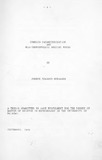| dc.description.abstract | Infrared (IR) satellite photographs of 1982 (August,
September) and 1983 (July, August, September) have been
used to study African waves. Prominent wave formations
were identified as clbu.d clusters, and their wavelength
was estimated by measuring the distance between the
clusters. The phase velocity of the disturbances was
estimated by tracking the movement of the cloud· clusteis
using consecutive images at 3h intervals. Streamline
and isotach analyses of the wind field at 850mb were
performed to supplement data on the position and
movement of perturbations. Using upper air sounding
from Dakar, Abidjan, Bamako, Khartoum and Nairobi, the
heights of cloud base and tops were computed by three
methods, namely:
(a) The Normand Point from tephigram; (b) the Dew-point
depression method and (c) the equivalent potential
temperature. The bouyancy of the atmosphere at the
above radiosonde stations was evaluated by. computing
the parcel excess, or log (potential temperature) to
investigate whether there was any inhibition to
convection. Kuo's (1965, 1974) model was applied to
determine the contribution by cumulus convection. The
model was run over a horizontal area extending from 200W
to 200E longitude, and from 00 to 200N latitude. The
average surface heat flux (Wm-2 ) generated by the model
was found to be more pronounced in areas of significant.
convection and large-scale low-level convergence. The
vertical heating profiles depict a maximum in the
mid-troposphere (650 - 500mb) a region where the
African wave perturbations are most pronounced.
The model also simulated convective rainfall rates
which were comparable to those observed by
Thompson et ale (1979) during the third phase of
the Global Atlantic Tropical Experiment (GATE).
We do not attempt in the present study to
parameterize these heating rates in terms of the
large-scale meteorological flow, but simply assert
that as maximum heating by convection occurs in
regions of maximum wave activity (mid-troposphere),
cumulus convection has a significant role to play ln
the genesis and dynamics of Africa Waves. This
should be incorporated in the mathematical models
used to simulate the properties and structural
characteristics of these waves | en |

